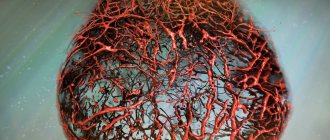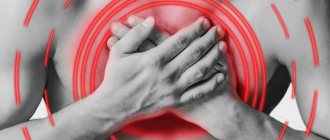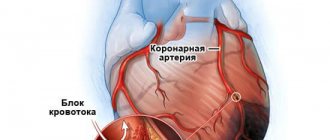In order to make a diagnosis of heart disease, the doctor acts according to the following plan: questioning, examination, palpation (palpation), percussion (tapping), auscultation (listening). Based on the results of these studies, a plan for further instrumental and laboratory examination methods is determined. Only based on the sum of all the data obtained can one conclude about the presence or absence of pathological changes and develop the correct treatment tactics.
Why are heart tests performed?
Despite the fact that the accuracy and availability of instrumental diagnostic methods increases every year, a medical examination and initial examination have not lost their relevance. This is due to the fact that only through direct contact with the patient can signs of the disease be established and its stage, risk factors influencing the clinical picture and the development of complications identified.
The objectives of the survey are:
- study of the boundaries of the heart and the bundle of blood vessels,
- study of vascular pulsation,
- determining the rhythm of contractions,
- listening to heart sounds and murmurs.
We recommend reading the article about cardiac auscultation. From it you will learn about the general rules of conduct, recommendations, conducting auscultation in children, and the results.
And here is more information about acquired heart defects.
Relevance of the procedure
Doctors call the main objectives of this technique:
- study of cardiac boundaries;
- listening to noises;
- study of the vascular bundle;
- listening to tones;
- clarification of the “contractile” rhythm;
- study of vascular pulsation.
Note! A physical examination of the organ is required. It includes palpation of the precordial zone and determination of the boundaries of its dullness.
Then there is a need to conduct auscultation of the heart. The auscultation procedure helps to identify pathological changes in the myocardium, vascular walls and valves.
Listening
How is palpation performed?
When palpating the area of the heart, the location and properties of the apical impulse are determined and the cardiac impulse is detected. Palpation is used to assess visible pulsation and tremors.
To conduct the examination, the palm of the right hand is moved from the sternum line to the armpits at the border of the 5th intercostal space. After detecting the impulse of the apex of the heart, its characteristics are determined by the digital phalanx without lifting the palm.
Palpation of the heart
When examining the chest, you can see the cardiac hump (gibbus cordis) - this is a protrusion of the chest wall in the area of the heart in the 3rd, 4th and even 5th intercostal spaces, which indicates a significant enlargement of the right ventricle, which appeared at an early age with a pliable chest. Thus, a cardiac hump is a sign of a congenital or acquired heart defect at an early age. General bulging of the atrial region, and especially smoothing of the intercostal spaces, occurs with effusion pericarditis.
An aortic aneurysm can cause destruction of the sternum and ribs when a protrusion in the form of an elastic tumor is noted in the second intercostal space on the right, pulsating upon palpation.
Dilatation of the veins on the anterior surface of the chest is observed with portal hypertension or with heart disease, in particular with pericarditis, especially adhesive, constrictive ones.
You can detect vascular pulsation, determine the apex beat, epigastric pulsation, which will be discussed when describing the cardiac palpation data.
Palpation of the heart. Palpation of the heart area First of all, the apical impulse described by Traube and its properties are determined. It is known that the heart is located on the diaphragm between the mediastinal organs and is fixed at the base by large vessels. The apex formed by the left ventricle is adjacent to the chest wall. It is freely mobile and during systole rises and moves forward, pressing against the chest wall. This is also facilitated by the elongation of large vessels in systole during their filling. The heart muscle itself becomes significantly denser during systole. Thanks to these two factors - the closest approach to the chest wall and maximum muscle density - it is possible to palpate and often see a periodic protrusion of the chest wall, synchronous with ventricular systole, which is called the apical impulse.
Determine the localization of the shock, its area (width), height and strength. Palpation is carried out with the palm of the right hand, located with the base of the hand towards the sternum, and with the fingers towards the axillary region.
Then they change the position of the fingers, positioning the hand vertically, and use the fingertips to clarify the localization of the apical impulse. It is usually located in the 5th intercostal space 1.5 cm medially from the left midclavicular line.
In a position on the left side, it shifts to the left by 3-5 cm, in a position on the right side - by 1-1.5 cm. It is more shiftable in asthenics. The area (width) of the apical impulse is 1.5-2 cm2. The magnitude of the span of the chest wall is called the height of the impulse. The apical impulse is easily palpable in young people, as well as in those with a thin chest wall. The height and width of the apical impulse decreases with obesity and swelling of the subcutaneous tissue. In addition, the apical impulse is not detected when it is not localized in the intercostal space, but is in contact with the rib. With exudative pericarditis, the apex beat is not palpable.
Palpation of the heart. Changing the localization of the shock. From neighboring organs, the position of the push is influenced by the position of the diaphragm. When the diaphragm is high (ascites, flatulence, pregnancy), the apical impulse moves slightly up and to the left. When the diaphragm is low (after childbirth, operations), it moves down and to the right. Various deformations of the chest shift the push. This is especially true for the kyphoscoliotic chest. Various processes in the lungs and pleura change the position of the push. Thus, exudative pleurisy and pneumothorax displace it to the opposite side, especially with left-sided localization. Pleuro-pericardial adhesions and atelectasis shift the impulse to the painful side. With dextacardia, the impulse is located on the right.
With enlargement and hypertrophy of the left ventricle, the impulse shifts to the left (to the anterior and even middle axillary line) and at the same time downward (in the 6-7 intercostal space). With hypertrophy of the pro-AV ventricle, it is shifted to the left.
With left ventricular hypertrophy, in addition to the displacement of the impulse down and to the left, its strength also increases. It becomes energetic, lifts the chest and becomes erect. It can become dome-shaped, giving the impression of a rolling hemisphere. Such a push is typical for aortic defects, and especially for aortic valve insufficiency. The impulse is increased in hypertension and some congenital heart defects.
When dilatation of the left ventricle occurs, the apical impulse becomes less strong and widens in area. It is palpated in the 2-3 intercostal spaces on the surface of the palm and is called diffuse.
With hypertrophy and dilatation of the right ventricle, not the apical point, but the cardiac point is determined, that is, oscillations over the entire region of the heart. In this case, as a rule, epigastric pulsation is observed. In these cases, the left ventricle is pushed aside and does not take part in the formation of the apical impulse.
The apical impulse can become negative, that is, with each systole, the intercostal spaces are retracted and not protruded, which occurs with adhesive mediastino-pericarditis, with pleuro-pericardial adhesions, which is explained by the direct pull of the contracting muscles of the ventricles, fused to the chest wall. But a negative apical impulse can also occur under other conditions.
With severe tricuspid valve insufficiency, the right ventricle ejects only part of the blood into the pulmonary artery, while a significant part of the blood returns to the right atrium and vena cava, as well as to the veins of the liver, which do not have valves that could prevent reverse blood flow. Due to the rapid drop in pressure in the right ventricle, diffuse retraction of the chest wall occurs. At the same time, during systole, a protrusion occurs in the liver area - the so-called positive venous pulsation. If you put one hand on the liver and the other on the heart, then the systolic pulse will be clearly felt above the liver, and diastolic return above the heart, that is, a return to the starting position (the so-called rocking phenomenon or swing symptom).
Sometimes additional impulses are added to the apex impulse in presystole or after it in protodiastole, during which additional tones are heard on auscultation (gallop rhythm).
With aortic valve insufficiency, the additional impulse of blood at the beginning of diastole due to regurgitation can be so pronounced that the apical impulse, as N.D. Strazhesko wrote, can become double. When the heart sounds increase (clapping first tone, accent of the second tone), you can feel short tremors corresponding to the tones (symptom of two hammers). With rough overlays on the pericardium, especially in the patient’s sitting position, bending slightly forward, you can palpate the friction of the pericardial layers, which on auscultation corresponds to a pericardial friction noise. The pulsation of the cardiac aneurysm can be palpated.
By palpation, you can also identify a peculiar phenomenon in the form of vibrations, trembling of the chest wall, the so-called “cat purring” (fremissement cataire), which depends on the swirling of the blood at the site of constriction. The phenomenon was described in 1811 by Corvisar, then in 1816 it began to be determined for heart defects. The name was given by Laennec, who associated it with mitral stenosis.
Most often, tremors are palpated at the apex of the heart in diastole; presystolic amplification occurs with stenosis of the left atrioventricular orifice. Trembling can be detected in the 2nd intercostal space on the right, and in these cases it is very pronounced, coincides with the sitola and indicates the presence of stenosis of the aortic mouth. The same phenomenon, but in the 2nd intercostal space on the left indicates stenosis of the pulmonary artery. This phenomenon can also be observed with other heart defects. With congenital defects, the trembling is localized according to the location of the defect. The presence of jitter always confirms the organic nature of the noise.
As mentioned above, you can palpate the pulsation of the aortic aneurysm in the area of 2-3 intercostal spaces. With an aneurysm of the aortic arch, with aortic valve insufficiency, you can feel the pulsation of the aorta in the jugular fossa, for which the patient must bring his shoulders forward and slightly raise them.
What does percussion reveal?
Tapping the borders of the heart helps determine the following indicators:
- the size of the organ
- outlines,
- location in the chest,
- the size of the bundle, consisting of the aortic and pulmonary trunks.
Most often, the patient stands with his arms hanging freely. In severe conditions and in small children, it is possible to perform percussion while lying down, but it should be taken into account that the size will be reduced. In infants, tapping is performed with the middle finger, and for adults, the middle finger-pessimeter of the left hand is needed. It is moved parallel to the expected boundaries. With the middle finger of the right hand, jerky blows are applied to the 2nd phalanx of the plessimeter.
In order to determine the size and outline of the heart, two types of diagnostics are used - determination of relative and absolute dullness.
Due to the fact that next to the heart sac there are lungs filled with air, when moving from them to the dense myocardium, the sound of percussion becomes dull.
The part of the heart that is not covered by lung tissue is projected onto the anterior region of the chest. It is called absolute dullness of the heart (ATC), and all true boundaries are called relative dullness (RTD).
With expansion of the cavities of the heart or myocardial hypertrophy, a displacement of the normal outlines occurs. In healthy people they are:
- ATS - the right line is located along the left edge of the sternum, the left - about 1 cm inward from the apical impulse, the lower - on the 4th rib, the upper - 2nd intercostal space.
- OTS - 1 cm outside the right edge of the sternum, on the left - the area of the apical impulse, below - the 3rd rib, above - the 2nd intercostal space.
Watch the video about performing cardiac percussion:
Diseases
Tactile perception of the apical cardiac impulse, which clearly deviates from normal values, as well as the ability to feel unnatural tremors and impulses of the heart muscle, can indicate diseases such as:
- A heart defect of a congenital or acquired nature, entailing all sorts of disturbances in the architectonics of the heart, which ultimately contributes to the development of myocardial hypertrophy;
- Arterial hypertension has been developing for quite a long time, often crossing the threshold of normal blood pressure with inflated values - up to 200 mm Hg.
- Aneurysm of the thoracic aorta,
- Pericarditis, in particular with the accumulation of a significant amount of fluid in the voids of the pericardium,
- Diseases of the bronchopulmonary system, adhesions in the pleural cavity, adhesive pericarditis.
Inspection and palpation of the heart area
In healthy people, the apical impulse is palpated 1 cm closer to the center than the line running in the middle of the left clavicle in the 5th intercostal space.
The displacement of this zone occurs:
- upward – with increased intra-abdominal pressure (pregnancy, tumor process, accumulation of fluid, gases);
- down and to the right - with a low position of the diaphragmatic septum (sharp weight loss, prolapse of internal organs, emphysematosis;
- to the left - with hypertrophy of the ventricular myocardium, a sign of aortic, mitral defects, hypertension, sclerotic processes.
If the apex beat is not in the typical place, then this is a sign of dextrocardia (right-sided heart) or accumulation of fluid in the pericardial cavity.
If the patient is healthy, then apart from the apical impulse in the precordial region there should be no other vibrations of the chest wall. When diseases are detected:
- Heart beat. It is felt throughout the palm as an intense shaking. Indicates hypertrophy of the right sections.
- Trembling, similar to a cat's purring. Appears when the aorta, pulmonary artery, mitral orifice narrows, or the aortic duct is not closed.
Decoding
For an experienced doctor, deciphering the results of cardiac palpation will not be difficult. The area of protrusion of the cardiac impulse has two square meters. cm. In the case of an increase in this area, the shock is called widespread. With a smaller plot, we are talking about limited.
Common push
A widespread beat occurs when the heart muscle is mostly attached to the sternum.
This is possible in the case of:
- Full breath;
- Pregnancy period;
- with tumor formations of the mediastinum.
If a widespread impulse is observed without one of these reasons, it means that there is an enlargement of some part of the heart.
Limited push
The limited impulse, accordingly, is a consequence of the smaller region of the heart being adjacent to the sternum.
This also has its origin:
- emphysema;
- low aperture;
- exudative pericarditis of the heart;
- hydro-, pneumopericardium.
Indentation of the sternum in the area of the heart impulse during contraction is a negative impulse. It occurs when there is evidence of enlargement of the right ventricle, displacing the apex of the left ventricle.
Other pulsations
The most important pulsations for establishing a diagnosis include pulsations: aorta, pulmonary artery and epigastric.
The appearance of unwanted aortic pulsation (invisible normally) is due to several reasons:
- shrinkage of the right lung;
- dilation of the aorta due to a sexually transmitted disease or aortic aneurysm.
- Abnormal pulsation of the pulmonary artery is a consequence of pulmonary hypertension due to mitral valve disorders.
- The epigastric pulsation is located in the epigastric fossa. Her origin:
- descent of the right ventricle;
- abdominal aortic aneurysm.
Sequence of heart palpation
Norm and deviations in readings
Data obtained during physical diagnostic methods, which include inspection, palpation, percussion and auscultation, should only be assessed by a doctor in combination with a survey and other diagnostic methods.
Percussion of absolute dullness of the heart
Narrowing of the boundaries, as a rule, is not associated with heart pathologies; it occurs with emphysema, pneumothorax and a low position of the diaphragm in thin patients. The boundaries have been expanded for the following diseases:
- mitral stenosis,
- pulmonary heart,
- tricuspid valve insufficiency,
- mediastinal tumors,
- cicatricial changes along the edges of the lungs.
Deviations from the norm of relative dullness of the heart
If the right border is shifted to the right, then this is evidence of mitral or pulmonary stenosis, accumulation of fluid or air in the chest.
A shift to the left is possible with asthenia, emaciation, right-sided pneumo- or hydrothorax.
Shift of the left OTS line more often occurs to the left side in the following diseases:
- aortic insufficiency,
- non-closure of the mitral valve,
- decompensated aortic stenosis,
- hypertension,
- acute myocardial ischemia,
- circulatory failure,
- high position of the diaphragm due to flatulence, obesity.
Auscultation of adults and children
Heart sounds are heard during the movement of vascular walls, valves, and blood flow during myocardial contractions. The norm is to listen to the first and second tones.
The first is the systolic tone. It includes the following components:
- valvular - closing of the valves between the atria and ventricles;
- muscular - contraction of the cardiac muscle of the ventricles;
- vascular – passage of blood into large vessels;
- atrial – pushing blood into the ventricles.
The second sound is diastolic, it is heard when the valves of the aorta and pulmonary artery close and the subsequent flow of blood through them.
The third tone occurs in adolescents and patients with malnutrition. It is caused by the movement of the ventricles during the phase of their filling and diastolic relaxation. The fourth sound is also diastolic and is heard before the first, when the chambers of the heart are completely filled with blood.
Tones are weakened in myocarditis, myocardial dystrophy. The first tone weakens with mitral and aortic insufficiency, narrowing of the aorta.
Strengthening 1 tone is associated with the formation of a cavity inside the lung with tuberculosis, pneumothorax, as well as mitral and tricuspid stenosis, tachycardia.
The second tone becomes muffled when the valves are not closed, since its valve part is missing, and there is low arterial and pulmonary pressure. Strengthening of the 2nd tone occurs with arterial hypertension over the aorta, and pathology of the mitral valve leads to an accentuation of the 2nd tone over the pulmonary trunk.











